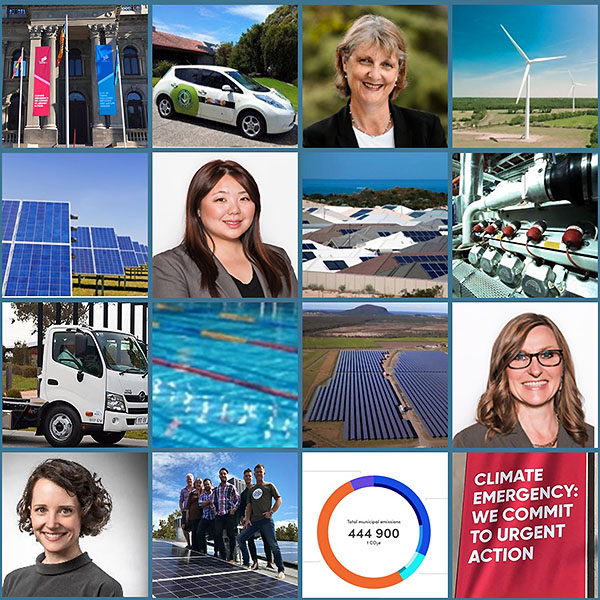Overview
Last Wednesday we welcomed a terrific panel to discuss climate solutions at a local government level. What are some best-practice programs and actions being implemented right now in Australia, and what are some of Boroondara City’s neighbors doing?
This is very timely, as community consultation for Boroondara’s new Climate Action Plan is well underway. We want to give you some ideas and inspiration for filling out your survey, and – leading up to this October’s council elections – some idea of what candidates could commit to to make Boroondara a leader in local climate action.
Video recording
For those who missed out, you can relive the night via a recording on our YouTube channel.
Hannah Snape, Climate Program Director at Ironbark Sustainability
(Hannah’s slides here)
Hannah starts with two questions to answer:
- What are some examples of climate projects undertaken by local governments in Australia or overseas that are innovative and effective? and
- What challenges face councils attempting to achieve climate action?
Broadly, council action on climate is split into two areas:
- Corporate actions: green buildings, street light upgrades, rooftop solar, EVs for their fleets etc.

- Community actions: renewable energy, sustainable transport, green buildings for residential and commercial, green industry etc.

Corporate emission initiatives have been done extremely well over the past decade in Australia, are directly controllable by the council and make financial sense. But, it’s very important to remember here that council corporate operations usually only account for 1% of their local government area’s total emissions.
Community emission initiatives are harder, but infinitely more variable in their possibilities. It doesn’t make a lot of financial sense for councils to directly intervene to fund these actions, rather councils should step back and consider how to influence the uptake of these actions: strategic planning, local regulations, education programs, facilitation etc.
Examples of great initiatives
Wollongong City Council
Wollongong is home to a massive industrial sector, which accounts for about 35% of the City’s total. Additionally, Australia’s largest steel manufacturing site (Bluescope’s Port Kembla steelworks) sits within their municipal boundary. Ironbark initially forecast that Wollongong had to cut its total emissions by 3-4% every year to meet its targets – steep challenge! (Hannah presented an updated figure to us of 4-5%, which now takes into account Australia’s rising emissions and shrinking carbon budget.)
Wollongong’s first step was to go and talk to Bluescope Steel. Luckily, Bluescope had already committed to the Paris Agreement and had developed a climate change and energy policy in September 2018. This completely flipped the problem on its head for Wollongong City: reducing emissions at Port Kembla didn’t need to be their flagship initiative, rather they could focus attention elsewhere and keep checking in with Bluescope to make sure things were on track.
Unnamed South Australian council (strategy plan pending approval)
Residential electricity use and transport dominated this council’s emissions profile, so residential solar programs were an obvious choice for this council. With SA it’s important to recognise that the greening of the SA electricity grid is steadily decreasing the emissions intensity of electricity there. If councils sit back and do nothing about electricity consumption in their community, their emissions will still drop.
But, this council also had one of the highest uptakes of rooftop PV systems in Australia, and there really weren’t any obvious opportunities on owner-occupier properties to increase this. The opportunity for more rooftop PV lay in rental properties, and there was an interested local stakeholder ready to drive the initiative. The council didn’t need to be throwing money at this, so it’s actually a fairly small program. Hannah reminds us here that the context of emission-reductions initiatives is important: the real value for this SA council was the behavior-change aspect of promoting residential solar. Climate action doesn’t necessarily need to be big $ programs to succeed and be effective.
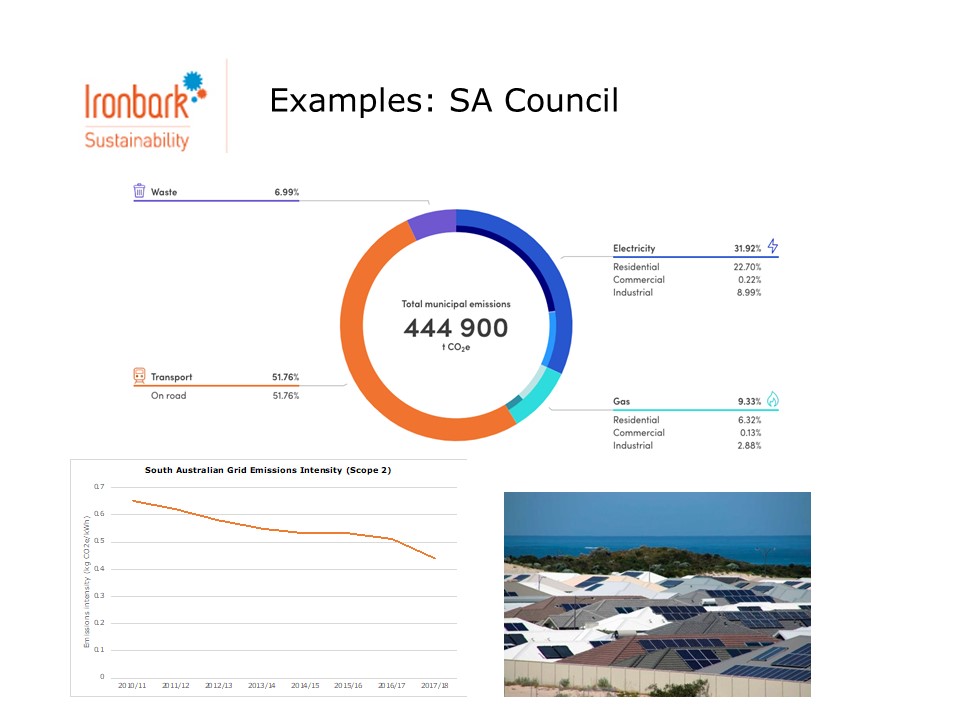
Sunshine Coast Council
Sunshine Coast City had it relatively easy! The City hosts a massive 15 MW solar farm. There was a unique set of circumstances that made this possible: political will, community approval and the availability of land. Achieving scale is really difficult in a climate emergency, so when the opportunity exists it needs to be taken.
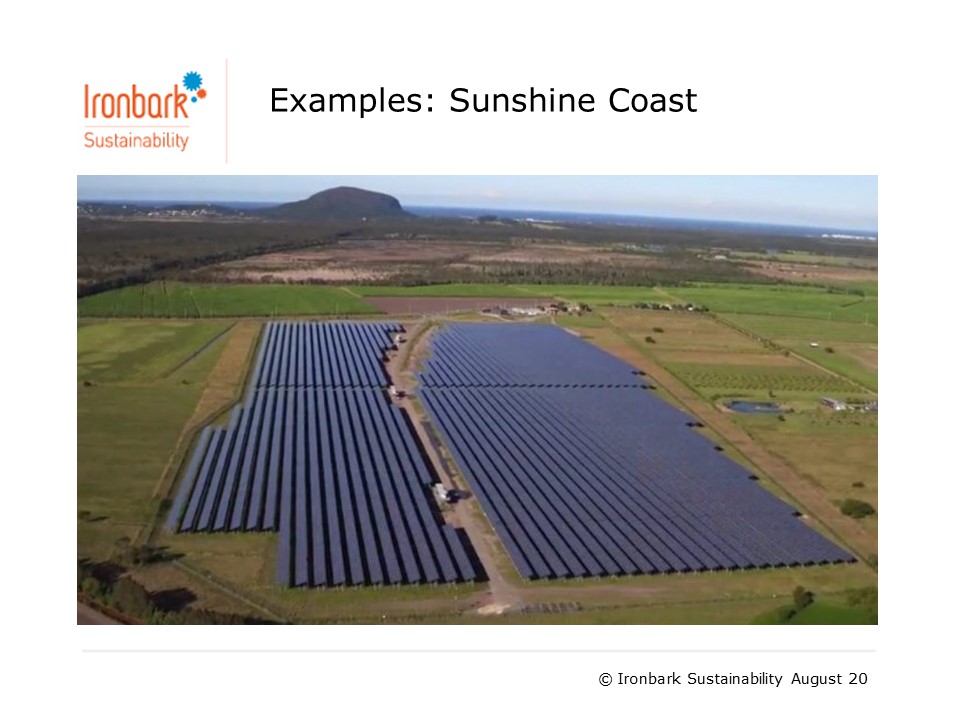
Moreland City Council
In 2012 Moreland installed a cogenerating energy system at the Fawkner Leisure Centre. At the time this was a cutting-edge, award-winning project: willingness to lead on new technology is very important. However a review in 2014 found that the system required much more maintenance and had a longer payback period than projected. So the business case wasn’t as solid as first thought. What made this project a game-changer was that Moreland shared this review information with other councils. Local governments are often politically-charged environments, so it’s crucial to make the climate solutions space one of patience, learning and an “OK to fail” attitude (within reason of course!). The need for success is a constant pressure in a climate emergency, but any solution needs to be effective in its local context.
What made this project a game-changer was that Moreland shared this review information with other councils. Local governments are often politically-charged environments, so it’s crucial to make the climate solutions space one of patience, learning and an “OK to fail” attitude (within reason of course!). The need for success is a constant pressure in a climate emergency, but any solution needs to be effective in its local context.
Best way to move forward
- Understand your emissions: where do they come from and who are the key stakeholders?
- Understand where you want to get to: what scale are you working at?
- Understand what’s already happening in your area? (eg. Wollongong and Bluescope)
- Constantly monitor, evaluate and be driven by what the data is telling you
Ironbark also produces the “Snapshot Climate” tool, an easy, highly-visual way for councils to analyse where emissions are coming from in their local area and assess where they can have the most influence.
Q&A for Hannah
Local governments worldwide have a body that participates in climate negotiations and sets its own targets – are you aware of the status and immediate plans of this body?
The Global Covenant of Mayors (GCOM) is a big one, and Ironbark has a lot of dealings with GCOM-aligned councils in Australia. One of the best things about involvement with GCOM is the reporting requirements are quite strict, so your action plans have to be up to scratch. A lot can be achieved outside GCOM too – there’s nothing that says a council has to be signed up to a particular body to achieve solid climate action.
How successful was the Wollongong-Bluescope partnership? Is this typical of council dealings with large corporations or atypical?
Wollongong got extremely lucky that Bluescope were already going down the right path. Hannah would suggest that other councils with significant industrial emitting sites are going to have a far tougher time – but the conversation still needs to start somewhere.
How can councils encourage the uptake of EVs?
Charging stations and EVs is a bit of a chicken-and-egg problem. Fear and misinformation around vehicle range is by far the biggest obstacle to EV uptake. Councils should research what the barriers are (eg. limited parking spaces, social norms of owning ICE cars, perception or actual inconvenience when charging sites are full capacity). Leadership in changing over the council’s fleet to EVs is a good step too.
Which Australian council has cut emissions the most?
Sadly without firm numbers around community emissions it’s hard to make a definite call on this one. Any South Australian council would be the front-runner, given the work from the SA state government to green their grid.
What actions can councils take to help shift residents off gas?
De-gasification is very important. Moving individual residential households off gas (retrofitting) is quite expensive and inconvenient, so focusing on new houses and not installing gas to begin with is the best. Planning regulations and council influence can have a lot of impact on this. Gas is used to heat in the industrial sector, so moving industry off gas and onto electric heat pumps (for example) is a great opportunity: you’re working with significantly less stakeholders and one or two pieces of technology.
Councillor Amanda Stone, Yarra City
(slides here)
Hannah’s outlined the key challenges for councils. Climate solutions can be an overwhelming space, and there’s no council that’s across everything – even a council like Yarra that appears to be highly progressive on climate action. Yarra City’s emissions snapshot demonstrates the challenge Cr Stone and her peers face: a huge portion of Yarra’s emission comes from commercial and industrial electricity use.
The Yarra Energy Foundation (YEF)
When Cr Stone was first elected ten years ago the solution to driving down community emissions (commercial and industrial especially) was to establish the Yarra Energy Foundation (YEF). A separate entity was needed because it could achieve things a council couldn’t: business partnerships, raising philanthropic funds etc. The YEF’s initial targets for community emission reductions were over-ambitious, so they had to be revised.
At a community level the YEF takes the work out of energy choices for consumers. Research shows people don’t want to spend more than eight minutes per year thinking about energy, so YEF provides all the advice, guides and tailored solutions for residents and businesses to reduce their emissions. Working with businesses on a 1-on-1 basis has helped change behaviours.
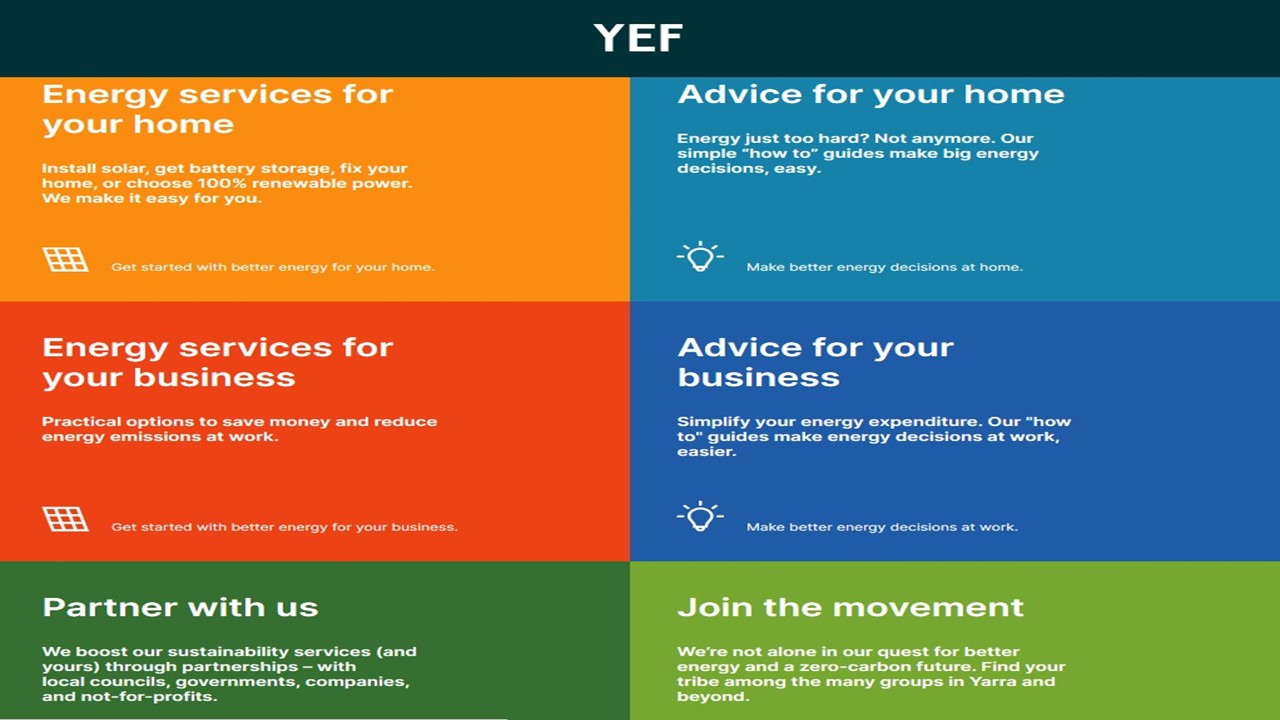
Businesses account for 60% of Yarra City’s emissions, so the YEF acting as a “broker” and advice-giver has worked wonders. There’s lots of microbreweries within Yarra City’s boundaries – energy-intensive outfits in often-rented factory spaces that don’t really know where to start with reducing their emissions. YEF had great success providing advice on rooftop solar for Stomping Ground brewery (see happy brewers below).
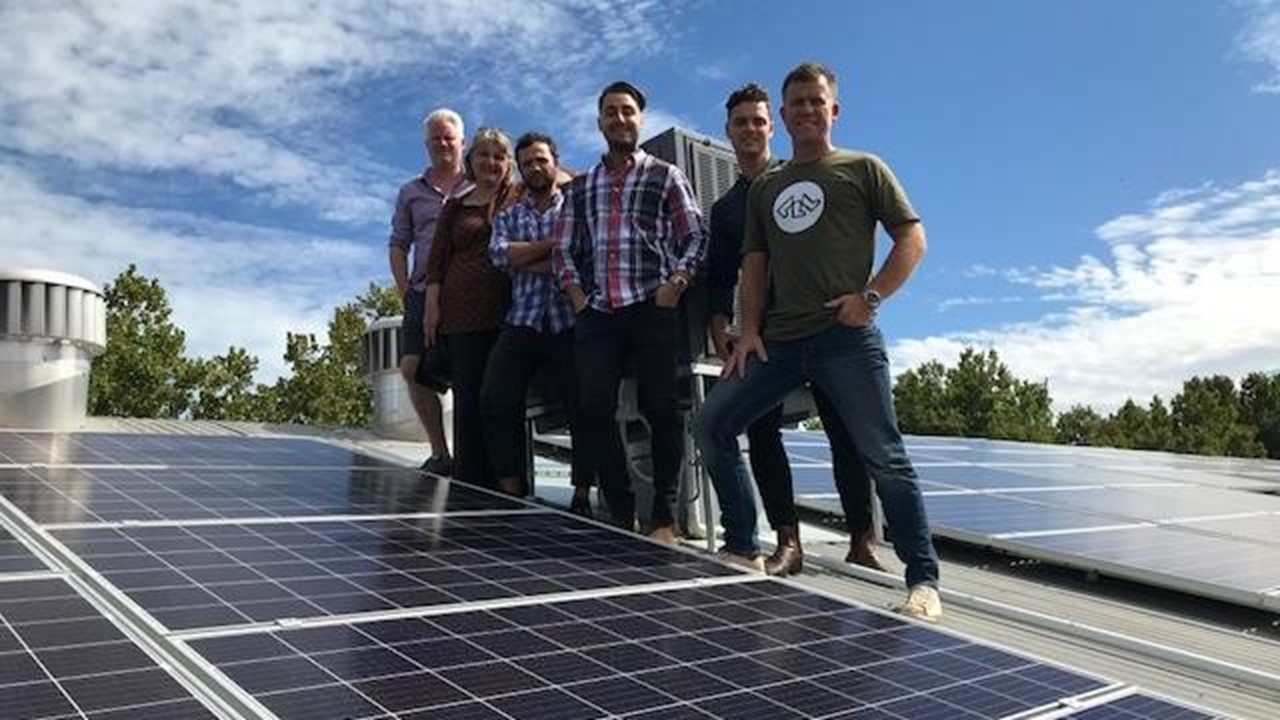
The Melbourne Renewable Energy Project
But while they were out in the community helping with their emissions, Yarra City had to address its own corporate emissions. The low-hanging fruit (rooftop solar, streetlight upgrades and de-gasification where possible) had all been completed and more was required. Yarra City was the first carbon-neutral council in Victoria, but much of that had been achieved by buying offsets, and the council wanted to move away from that.
The answer was a big partnership: Yarra City, neighboring councils, University of Melbourne, CSIRO, Federation Square and Melbourne Zoos all banded together as a consortium put a big energy acquisition package out to tender. Pacific Hydro were successful, constructing an entirely new wind farm at Crowlands near Ararat and stimulating the renewable energy industry in Victoria on the back of the tender. Ten years guaranteed electricity at a contracted price was a boon at a time when wholesale prices were highly variable. Even better, the Melbourne Renewable Energy Project was a model for initiatives to come.
A current big initiative is changing the state planning scheme to mandate that all new buildings must be zero carbon in performance. Yarra is currently working with other councils on an amendment to the Victorian planning scheme to put before the Vic Planning Minister. Unfortunately these decisions can take time and there’s no firm timelines around this.
Yarra City is also transitioning its council fleet to all-electric. Their first electric truck arrived recently, and the hope is to transition all their waste collection vehicles to electric.
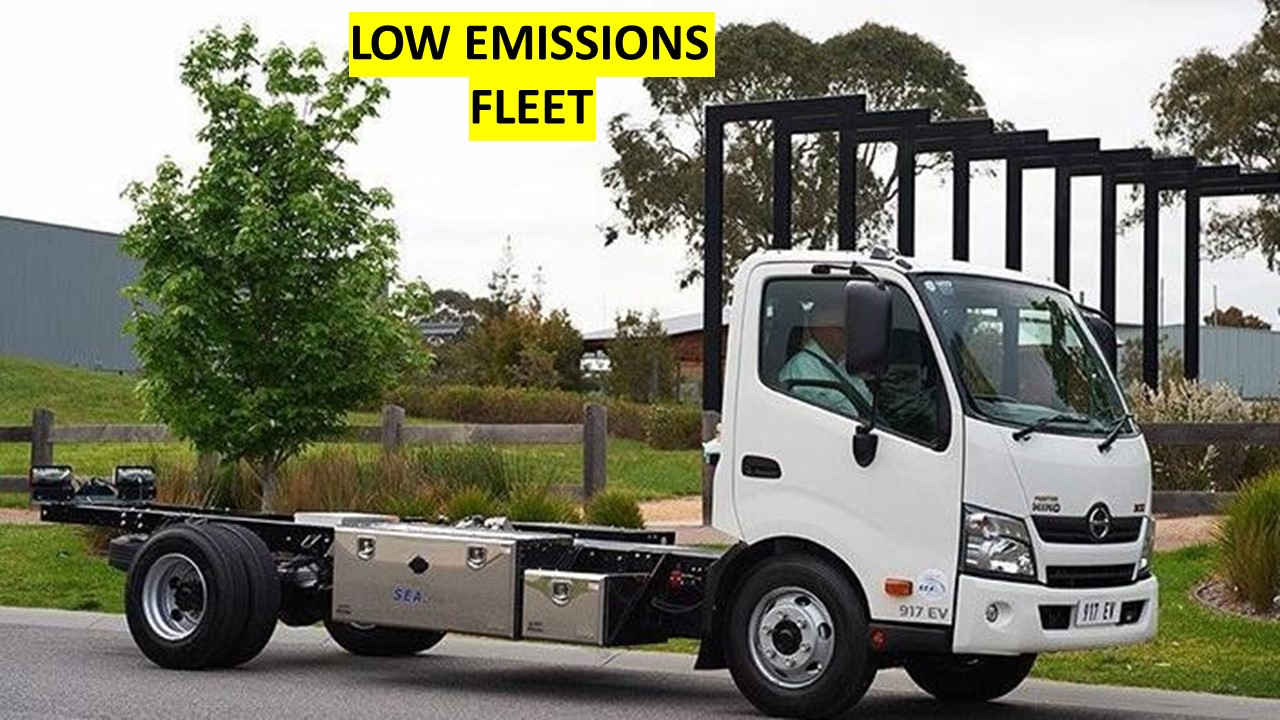
In the meantime community interest on climate action is growing. Councils often do this delicate dance with the community: who leads and who drives? Community momentum over declaring a climate emergency reached such a pitch in Yarra that the declaration of climate emergency was a formality. All 3 Town Halls proudly display climate emergency banners (pictured below is Collingwood Town Hall), the City hosts a series of events with high profile speakers on climate action, and Yarra just adopted a bold new Climate Emergency Plan, with an aim to get community emissions to zero by 2030. Yarra City will partner with the YEF to mobilise the local community to reduce their emissions by seeking out influential community members, partnering with businesses and climate action groups and continuing to provide educational events and programs.
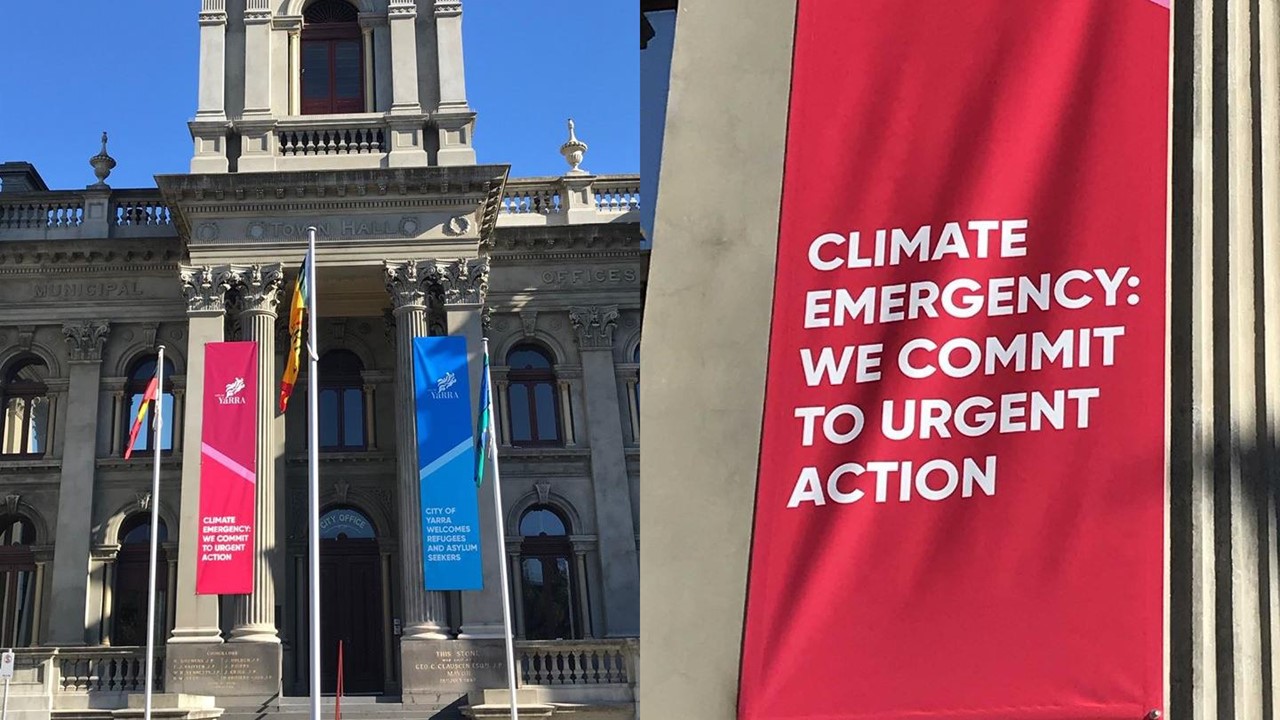
Cr Stones’s wishlist for the future? She’d love to see:
- Yarra City get off gas. There’s cogeneration power at some leisure centres but it still uses gas, and in some scenarios the technology isn’t quite ready to disconnect.
- The council to require all new buildings to be zero carbon, as well as transitioning old building stock to zero carbon. This will be difficult and will require some carrot and some stick, but it will be worth it.
- People out of vehicles and for street space to be shared between vehicles, bikes and pedestrians.
- And for renewable energy to be available and easily packaged for the entire community.
Q&A for Cr Stone
Does YEF only work with Yarra-centred businesses? If not, are there brokers for other council areas?
YEF does branch out to act as a broker for solar bulk buys. They’ve developed a model that’s very easy to implement and gets a lot of people involved, and it’s been taken up by other councils. In business terms YEF is Yarra-focused, but the model and function has been repeated in other council areas, such as the Gippy Bulk Buy in Gippsland.
Has it been easy to garner support for changes to the planning laws?
No objections from the community. The difficult part has been getting DELWP (Dept of Environment, Land, Water and Planning) to approve these planning scheme amendments. It’s a tortuous process. Nine councils banded together in 2009 to push amendments and it wasn’t approved until 2016. Which is incredibly frustrating, given we have limited time to address the climate emergency.
What is to be gained in declaring a climate emergency? (particularly Boroondara and Whitehorse)
No one batted an eyelid in Yarra. We can take away car parking spaces for a bike rack and we’re inundated with negative emails, but when we declare a climate emergency no one says boo. Cr Stone thinks the fear of declaring is significantly overrated, and that the benefits of a declaration are that the council is seen to be taking this issue seriously and is committed. Now certainly any declaration needs to be followed up with action. And, although some councils have baulked at the word emergency (but still committed to a plan or strategy) the fact that we have widespread community and government support of measures to fight another invisible enemy (COVID-19) tells Cr Stone that people get the idea. The fear of declaring a climate emergency is misplaced and just needs to be overcome.
What’s your advice for Boroondara citizens to be effectively involved in community consultation?
Be honest about what you’d like to see. Cr Stone is confident that the Boroondara Councillors – when it comes to listening to and responding to community needs – are on the same page as she is, though they might not be politically aligned. All Councillors want to hear from their community and respond. You don’t need to be feral or crazy, just provide your honest input. Looking at the questions coming through the chat box, Cr Stone is extremely impressed at the knowledge being demonstrated and that we should be confident with our suggestions. Informed, serious, authentic input to your council is the best thing you can do.
Councillors Tina Liu and Prue Cutts, Whitehorse City
(slides here)
Whitehorse’s Climate Response Plan feeds directly into their Sustainability Strategy, and this in turn is helping to shape a broad 2040 “Community Vision” for the City. Another feed-in to Sustainability is the Planning Scheme, with two components that are relevant here:
- Environmentally Sustainable Design (ESD) policy, and
- The Whitehorse-famous Amendment C219, which covers landscaping overlays and protecting tree canopy cover.
As a member of the Eastern Alliance for Greenhouse Action (EAGA), Whitehorse City has a number of initiatives completed and on the go:
- The Whitehorse Energy Performance Contract, which has secured permanent energy, emissions and financial savings and a short payback time. Eight of Whitehorse’s top energy consuming facilities are part of the $2 million, 2 year energy efficiency project. Rooftop solar on Aqualink Box Hill, the Box Hill Town Hall and other significant sites are the first year’s focus, with lighting efficiency upgrades to follow in the second year.
- Whitehorse’s first 5 Star GreenStar accredited building (the Nunawading Community Hub).
- A regional ESD policy across EAGA councils.
- Playing a stronger advocacy role as part of EAGA, for example via a submission made to the Australian Energy Market Commission.
- A proposed Business Resilience Program to act as a source of advice and guides for businesses wanting to reduce their carbon footprint.
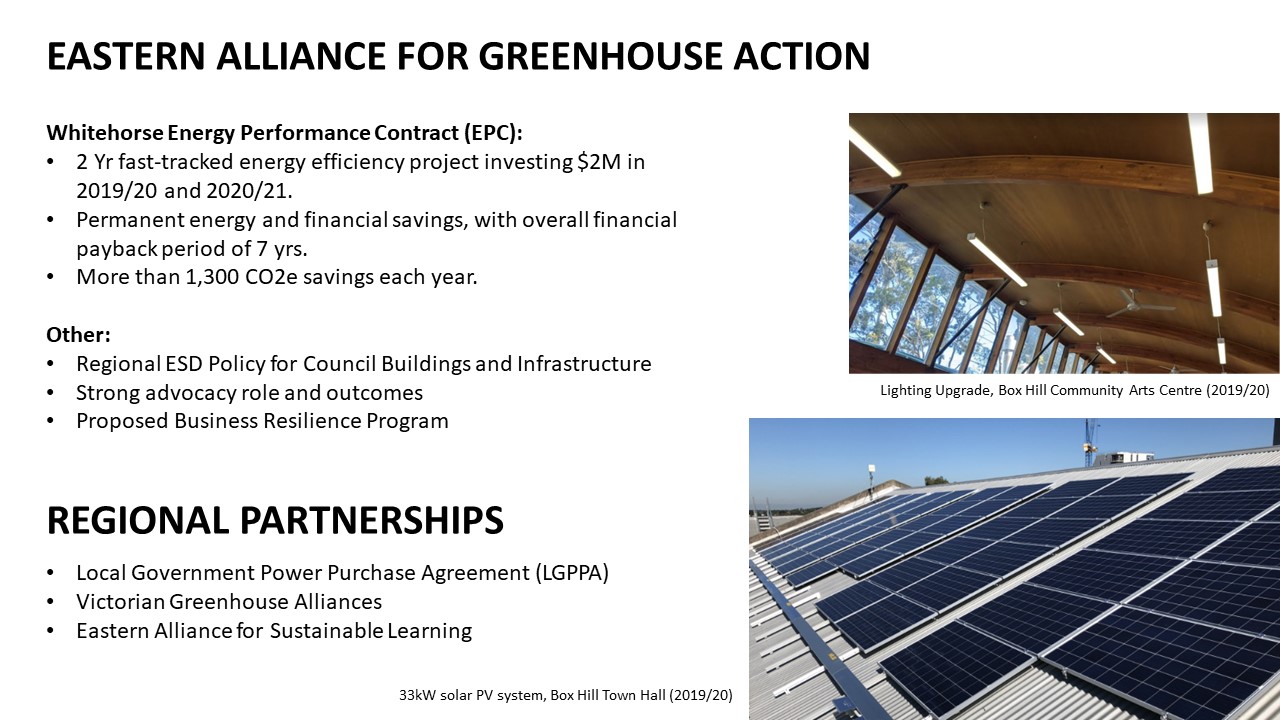
Amendment C219 and Tree Canopy Cover in Whitehorse
Whitehorse is considered a green, leafy area of the Melbourne suburbs, so the above graph should come as a shock. When Cr Cutts started on council in 2016 she was told the figures were around 22-26% tree canopy cover, and a University of Technology Sydney study in 2013 put the figure at 22.9%. The significant drop in canopy cover over the past seven years has come in spite of strong tree controls (including a 2018 strengthening amendment), and is quite distressing to Cr Cutts.
Trees are simply running out of spaces to grow in Whitehorse. Council actions to counter this include encouraging residents to grow wide-canopy, tall trees on their properties, planting out street kerbs and road reserves, planting out council-owned parkland and running a series of education programs on the value of tree canopy cover to health and climate action. Cr Cutts asks all Whitehorse people to make more noise about the amount of trees being cut down for development. She raises the issue constantly at council meetings but doesn’t get enough vocal support, and recently development applications that “moonscape” sites have been given the green light by council – we’ve got to stop this!
Q&A for Crs Liu and Cutts
How do you encourage more residents to plant trees?
Whitehorse Sustainability and Tree Education Officers are working 1-on-1 with residents for options and advice for tree planting, so reach out if you need help and encourage your friends to do so as well. Cr Cutts acknowledges that it’s often frustrating for residents: someone wants to remove an old tree and gets knocked back but a developer gets the green light to moonscape a site just down the road! Educating residents, fixing attitudes within council to non-environmentally friendly development and changing the planning scheme to prevent moonscaping are all important parts of conserving tree canopy cover.
What can Whitehorse residents do to make sure a new climate emergency declaration would succeed (a motion failed earlier this year): work closer with Councillors, push harder? Is an emergency declaration important for Whitehorse City?
Cr Liu and Cutts certainly don’t have an issue with declaring a climate emergency, and Cr Liu believes a declaration would signal Whitehorse’s intent that this issue is serious and needs to be addressed asap. Cr Liu encourages everyone in the audience to speak up and engage: she gets a lot of correspondence from her constituents about climate and wants to see other Councillors get the same level of engagement.
Cr Cutts asked the question of her constituents over Facebook and got a resounding yes (~80% supported a declaration), but when they took the issue to a full vote they lost. She worries other Councillors don’t even see the legitimacy of the issue! With elections coming up Cr Cutts would love to see Whitehorse candidates asked what their stance is on climate and that the community make these issues a priority at the upcoming election. Whitehorse is going backwards, not forwards, especially on tree cover and subsequent heat island effects.
Cr Cutts also wants to make sure that people separate Whitehorse City from its Councillors when describing the organisation as a “pro-development, business as usual”. She has no hesitation in describing other Councillors as climate-action averse, and she and Cr Liu were disappointed to see their climate emergency motion defeated in a 4-5 vote. Cr Cutt’s advice? Make a lot of noise on this issue or stand as a Councillor to see a shift in this thinking! Both she and Cr Liu would love to be joined in office by other pro-climate action Councillors.
Event resources
- Youtube recording here.
- Tweet-string here.
- Hannah’s slides, Cr Stone’s slides and Cr Liu and Cutts’ slides.
“Thank you so much to our wonderful panel – we certainly got a full evening of climate solutions at a local government level. Thank you to our audience as well: 175 people is our biggest online crowd (even bigger than our July event with Lidia Thorpe!), and we’re also grateful for the donations that came through after the event. Combined with our generous July donors Lighter Footprints is in a great position to have a big impact at the upcoming Boroondara council elections. We can keep bringing you engaging monthly events for the rest of 2020 and beyond – stay tuned!”
Things to do
- Before 14 September, tell Boroondara Council what you want in their Climate Action Plan by completing their survey
- Before 30 September, register here for our big Boroondara Candidates Forum, Wednesday 30 September, 7:30 pm. We’ll gather together in a central meeting before breaking off into separate wards. All ward candidates will be invited to answer climate and governance questions before we open the floor to you, the Boroondara constituents. Who is our Guest Celebrity?

